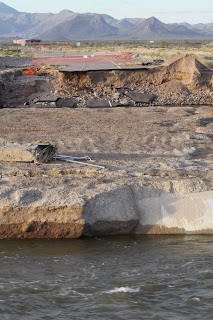
There is an old Spanish saying, translated into English it says, "What man proposes, God disposes." Some definitions are in order: (from the USGS)
cubic feet per second (cfs)--a rate of the flow, in streams and rivers, for example. It is equal to a volume of water one foot high and one foot wide flowing a distance of one foot in one second. One "cfs" is equal to 7.48 gallons of water flowing each second. As an example, if your car's gas tank is 2 feet by 1 foot by 1 foot (2 cubic feet), then gas flowing at a rate of 1 cubic foot/second would fill the tank in two seconds.
discharge--the volume of water that passes a given location within a given period of time. Usually expressed in cubic feet per second.
flood--An overflow of water onto lands that are used or usable by man and not normally covered by water. Floods have two essential characteristics: The inundation of land is temporary; and the land is adjacent to and inundated by overflow from a river, stream, lake, or ocean.
The picture above shows what happens to roads in the Salt River Valley when the road builders disregard all of the above definitions.
cubic feet per second (cfs)--a rate of the flow, in streams and rivers, for example. It is equal to a volume of water one foot high and one foot wide flowing a distance of one foot in one second. One "cfs" is equal to 7.48 gallons of water flowing each second. As an example, if your car's gas tank is 2 feet by 1 foot by 1 foot (2 cubic feet), then gas flowing at a rate of 1 cubic foot/second would fill the tank in two seconds.
discharge--the volume of water that passes a given location within a given period of time. Usually expressed in cubic feet per second.
flood--An overflow of water onto lands that are used or usable by man and not normally covered by water. Floods have two essential characteristics: The inundation of land is temporary; and the land is adjacent to and inundated by overflow from a river, stream, lake, or ocean.
flood, 100-year--A 100-year flood does not refer to a flood that occurs once every 100 years, but to a flood level with a 1 percent chance of being equaled or exceeded in any given year.
flood plain--a strip of relatively flat and normally dry land alongside a stream, river, or lake that is covered by water during a flood.
flood stage--The elevation at which overflow of the natural banks of a stream or body of water begins in the reach or area in which the elevation is measured.
peak flow--the maximum instantaneous discharge of a stream or river at a given location. It usually occurs at or near the time of maximum stage.The picture above shows what happens to roads in the Salt River Valley when the road builders disregard all of the above definitions.
No comments:
Post a Comment